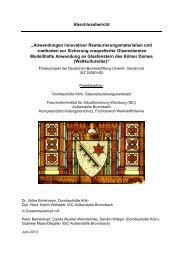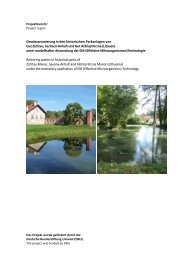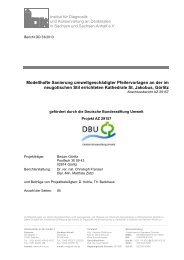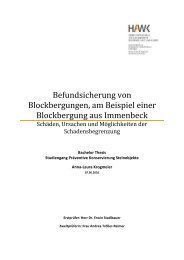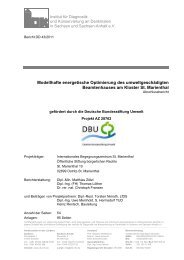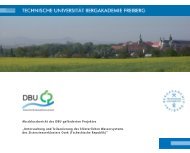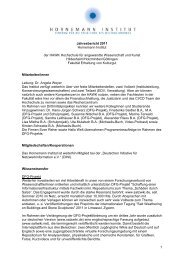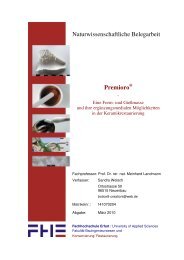Download PDF
Download PDF
Download PDF
Erfolgreiche ePaper selbst erstellen
Machen Sie aus Ihren PDF Publikationen ein blätterbares Flipbook mit unserer einzigartigen Google optimierten e-Paper Software.
Weichmacherverlust bei PVC-Objekten von Joseph Beuys – Versuche zu kurativen und konservatorischen Massnahmen<br />
ANHANG III: ZUSAMMENSTELLUNG VON ABSTRACTS<br />
plasma changed from 900 to 10,800 s. Through contact angle measurements, the effect of the exposure time on the<br />
PVC wettability was investigated. Independent of t, all samples presented contact angles, [theta], equal to zero after<br />
the treatment. However, in some cases, surface hydrophilization was not stable, as revealed by the temporal<br />
evolution of [theta]. Samples bombarded for shorter periods recovered partially or totally the hydrophobic character<br />
while the one exposed for the longest time stayed highly hydrophilic. These modifications are ascribed to the Cl loss<br />
and O incorporation as shown by XPS measurements. Furthermore, the mobility of surface polar groups and the<br />
variation in the cross-linking degree can also affect the PVC wettability.<br />
Kaczmarek, Halina; Kowalonek, Jolanta; Szalla, Aleksandra; Sionkowska, Alina (2002): Surface modification of<br />
thin polymeric films by air-plasma or UV-irradiation. In: Surface Science, vol.s 507-510, June 2002, S.<br />
883-888<br />
Commercial, purified poly(vinyl chloride) (PVC) in a form of thin film was used for modification by low-temperature air-<br />
plasma or short-wavelength UV-irradiation. The changes of surface properties were monitored by contact angle<br />
measurements allowing for calculation the surface free energy as well as its polar and dispersive components.<br />
Both modification sources cause surface oxidation of PVC films, which is connected with formation of functional<br />
groups enhancing polymer wettability. This process is very fast and efficient in air-plasma but slower during PVC<br />
exposure to UV.<br />
Storage of modified PVC indicates that in plasma also conformational changes occur. In case of UV-irradiated PVC<br />
secondary, dark reactions (mainly oxidation) take place during storage at ambient conditions.<br />
Dumitrascu, N.; Borcia, G.; Popa, G. (2001): Corona discharge treatments of plastified PVC samples used<br />
in biological environment. In: Journal of Applied Polymer Science, Volume 81, Issue 10, Date: 6 September<br />
2001, S. 2419-2425<br />
The effects of the plasticizer content and of the treatments by corona discharge in helium on the morphology and on<br />
some physico-chemical properties of the PVC surface were investigated by scanning electron microscopy (SEM), IR<br />
spectroscopy, and contact angle measurements. A biological test of adsorption of some ions (calcium, potassium,<br />
and sodium) from human serum sanguine on the surface of PVC was also performed. After corona discharge<br />
treatment, the surface morphology presents a cleaning of oligomers and an increase in porosity, depending on the<br />
treatment time and on the content of the plasticizer. Surface energy considerably increases and functionalization of<br />
the surface is observed after treatment by corona discharge in helium. This functionalization does not change the<br />
electrolitical equilibrium of some ions from the serum sanguine, a convenient result that controls the stability of the<br />
blood-PVC sample interface.<br />
Audic, J.-L.; Poncin-Epaillard, F.; Reyx, D.; Brosse, J.-C. (2001): Cold plasma surface modification of<br />
conventionally and nonconventionally plasticized poly(vinyl chloride)-based flexible films: Global<br />
and specific migration of additives into isooctane. In: Journal of Applied Polymer Science, Volume 79, Issue<br />
8, Date: 22 February 2001, S. 1384-1393<br />
Balazs, D.J.; Triandafillu, K.; Wood, P; Sardella, Harms, H.; van Delden, S.; Favia, P.; d’Agostino, R.; Hollenstein, C.;<br />
.; Mathieu, H.J. (2001): Surface modification of PVC endotracheal tube surfaces to reduce<br />
pseudomonas aeruginosa adhesion: plasma processing and chemical methods. In: European Cells<br />
and Materials, Vol. 6, Suppl. 1, S. 86




